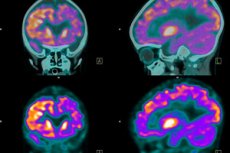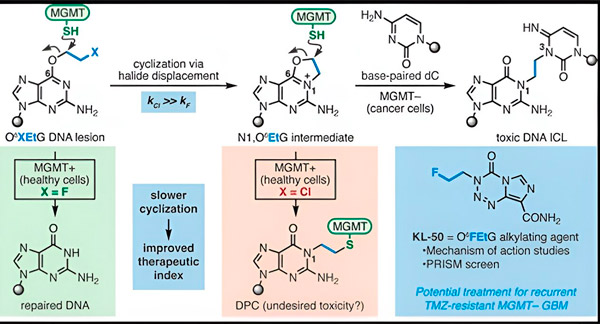
耶鲁大学科学家的一项新研究描述了一种新型化合物如何攻击耐药性脑肿瘤而不损害健康的周围组织。
这项研究发表在《美国化学学会杂志》上,是开发所谓的“变色龙化合物”的重要一步,可用于对抗一系列危险的癌症。
每年每 100,000 人中大约有 6.6 人患上神经胶质瘤,到 14 岁时每 100,000 人中大约有 2.94 人患上神经胶质瘤。不包括到达中枢神经系统的其他癌症转移,神经胶质瘤占所有脑肿瘤(原发性脑肿瘤)的 26% 和所有恶性脑肿瘤的 81%。
几十年来,胶质母细胞瘤患者一直使用一种名为替莫唑胺的药物治疗。然而,大多数患者在一年内就会对替莫唑胺产生耐药性。胶质母细胞瘤患者的五年生存率不到5%。
2022年,耶鲁大学化学家塞思·赫尔宗(Seth Herzon)和放射肿瘤学家兰吉特·宾德拉(Ranjit Bindra)博士开发了一种更有效治疗胶质母细胞瘤的新策略。他们创造了一类名为“变色龙”的抗癌分子,这种分子利用了一种名为O6-甲基鸟嘌呤DNA甲基转移酶(MGMT)的DNA修复蛋白的缺陷。
许多癌细胞,包括胶质母细胞瘤,都缺乏MGMT蛋白。新型变色龙化合物旨在破坏缺乏MGMT的肿瘤细胞的DNA。
变色龙化合物通过在DNA上沉积原发性损伤来引发DNA损伤,这些损伤会随着时间的推移演变成剧毒的次级损伤,即链间交联。MGMT通过修复原发性损伤,防止其演变成致命的链间交联,从而保护健康组织的DNA。
在他们的新研究中,共同作者 Herzon 和 Bindra 将重点关注他们的领头变色龙 KL-50。
耶鲁大学米尔顿·哈里斯化学教授赫尔宗表示:“我们结合合成化学和分子生物学研究,阐明了我们先前观察结果的分子基础,以及赋予这些化合物独特选择性的化学动力学。我们证明,KL-50 的独特之处在于它仅在 DNA 修复缺陷的肿瘤中形成 DNA 交联。它不会影响健康组织。”

来源:《美国化学会志》(2024)。DOI:10.1021/jacs.3c06483
研究人员指出,这是一个显著的差异。许多其他抗癌化合物已被设计用于触发链间交联,但它们对肿瘤细胞不具有选择性,从而限制了它们的用途。
研究人员指出,KL-50 成功的秘诀在于其时机。KL-50 形成链间交联的速度比其他交联剂慢。这种延迟使得健康细胞有足够的时间利用 MGMT 来阻止交联的形成。
“这种独特的特性表明,该疗法有望用于治疗耐药性胶质母细胞瘤,而这一领域在临床上存在大量未满足的需求,”耶鲁大学医学院哈维和凯特·库欣治疗放射学教授宾德拉说道。宾德拉同时也是斯米洛医院切尼维特家族脑肿瘤中心的科学主任。
Herzon 和 Bindra 表示,他们的研究强调了考虑化学 DNA 修饰和生化 DNA 修复速率的重要性。他们相信可以利用这一策略开发针对其他存在特定肿瘤相关 DNA 修复缺陷的癌症的治疗方法。

